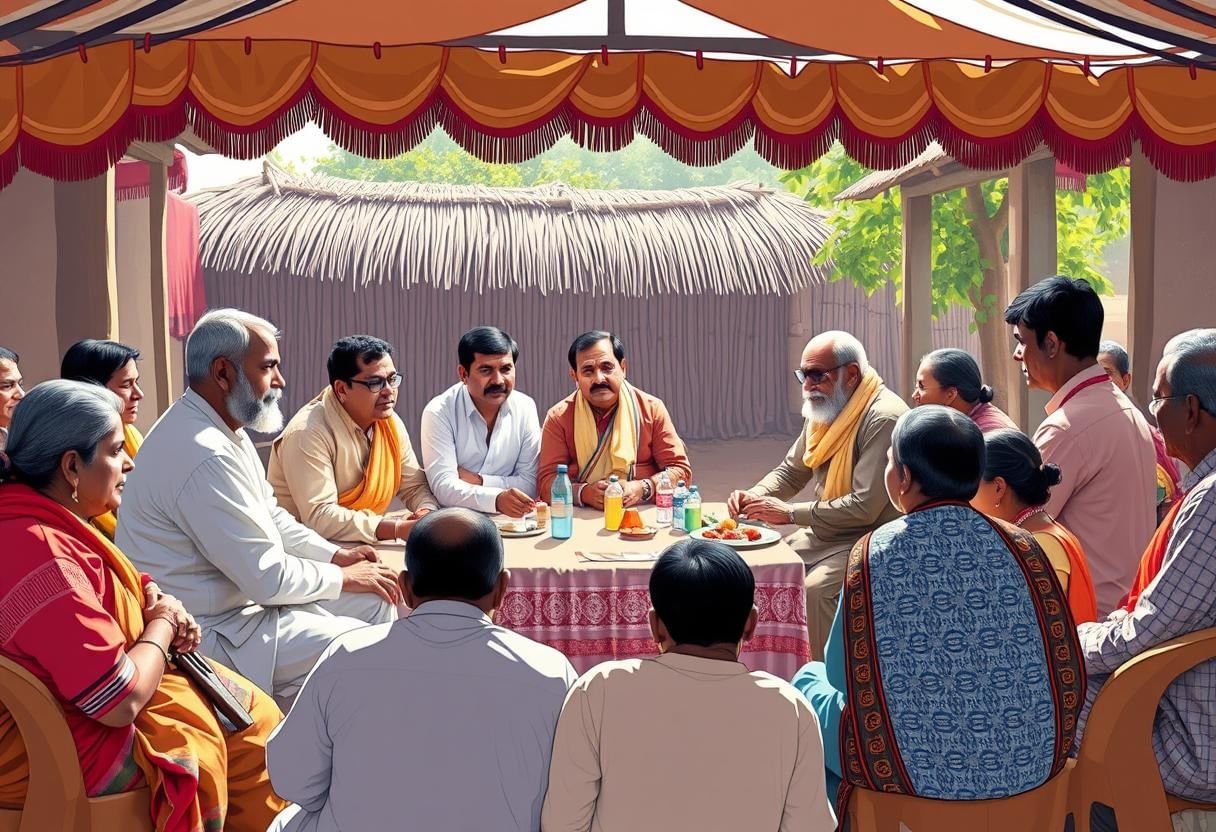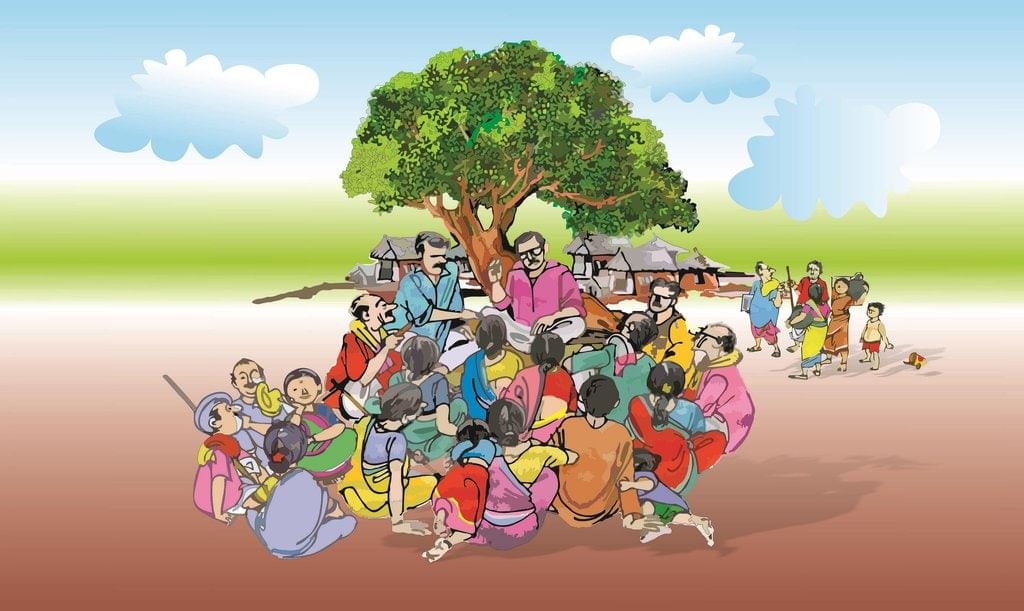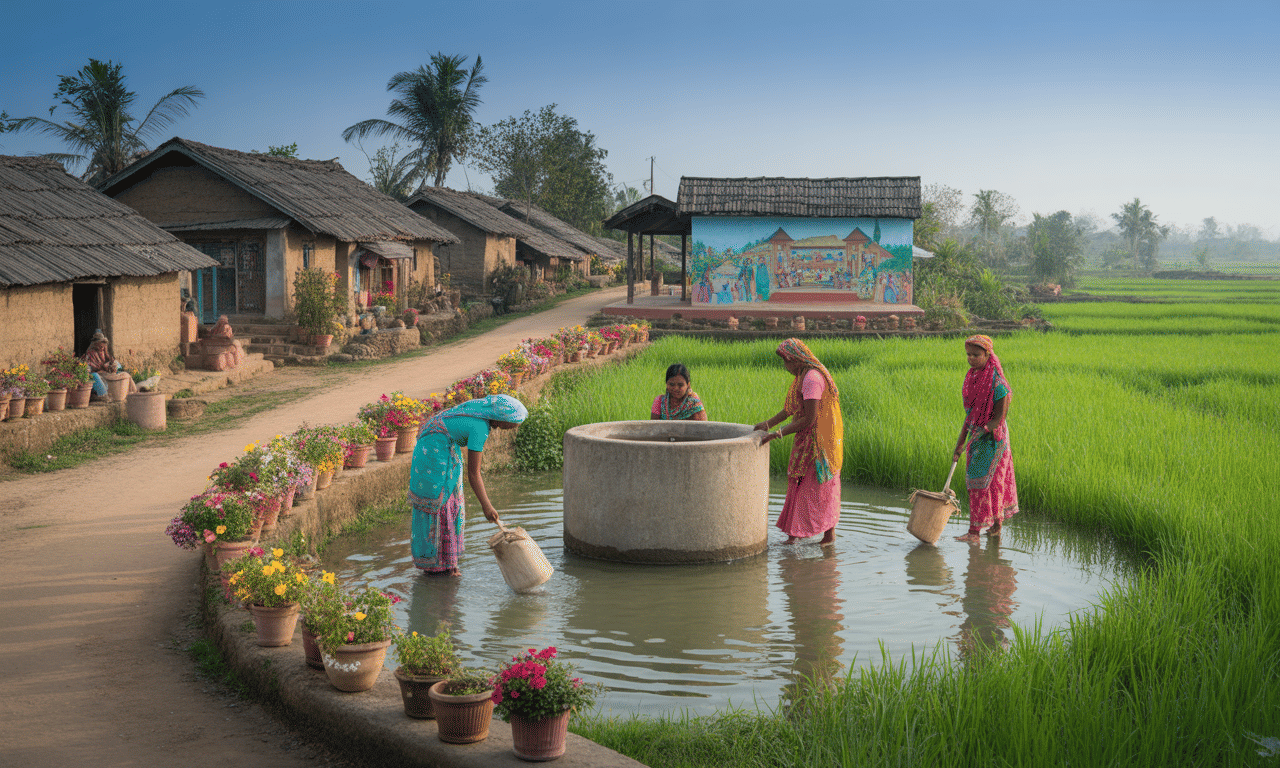Class 6 Exam > Class 6 Notes > Chapter Notes For Class 6 > Chapter Notes: Panchayati Raj
Class 6 Civics Chapter 4 Notes - Panchayati Raj
| Table of contents |

|
| Panchayati Raj System |

|
| Gram Sabha |

|
| Gram Panchayat |

|
| Three Levels of Panchayats |

|
Panchayati Raj System
- A process through which people participate in their own government.
- The Panchayati Raj system is the first tier or level of democratic government.
- It functions at three levels:
Zila Parishad: The Zila parishad or District Panchayat is the highest level of Panchayati Raj system.
Panchayat Samiti: The Panchayat Samiti functions at the block level under the Zila Parishad.
Gram Panchayat: Under the Panchayat Samiti there are many Gram Panchayats that comprise Panchs and Sarpanchs at village level.
 Village Governance
Village Governance
Question for Chapter Notes: Panchayati RajTry yourself:What is the highest level of the Panchayati Raj system?
View Solution
Gram Sabha
- The Gram Sabha meeting in the Hardas village is being attended by everyone in the village.
- The Gram Sabha at Hardas village is holding its first meeting after the election of the new Gram Panchayat.
- The Gram Sabha meeting of the village begins with the panchayat president addressing the problems that are being faced by the people of Hardas village in regards to its roads.
- The Panchayat President is also known in the village as the Sarpanch of Hardas village.
- The Sarpanch is being joined in the meeting by the other members of the Hardas village panchayat who are known as the Panch.
- The Gram Sabha meeting begins with discussions about the plan for repairing the village road that connects Hardas village to the main highway.
- After that discussion, the meeting takes on the subject of water and water shortages that are being faced by the village.
- The Gram Sabha is a meeting where all adults who live in the area are covered by a Panchayat.
- Every village Panchayat is divided into wards that are similar to areas.
- Each of these wards or areas elects a representative who is known as the Ward member or Panch.
- The Sarpanch of the Gram Sabha is elected by all the members of the Gram Sabha and is the Panchayat President.
- The Gram Panchayat is, therefore, formed by the Ward Panch and the Sarpanch of the village.

- The duration of the Gram Panchayat for enjoying its governance over the villagers is for five years.
- The Gram Panchayat also contains a secretary of the organisation.
- This secretary also acts as the secretary of the Gram Sabha.
- The secretary, however, is not elected by the people or the Panchs of the village, and that person is appointed by the Government of India instead.
- The primary job of the secretary is to call the meeting of the Gram Sabha and the Gram Panchayat, along with keeping a record of the village meetings and proceedings.
Functions of Gram Sabha
- It is the place where all plans for the work of the Gram Panchayat are placed before the people.
- The Gram Sabha is a key factor in making the Gram Panchayat play its role and be responsible.
- The Gram Sabha is the place in a village where all plans for the work of the Gram Panchayat concerning the village are placed before the villagers.
- The Gram Sabha prevents the Panchayat from doing wrong things like misusing money or favouring certain people in the village over others.
- Therefore, the Gram Sabha plays an important role in keeping an eye on the representatives of the village wards and in holding them responsible to the villagers who elected them.
Question for Chapter Notes: Panchayati RajTry yourself:What is the purpose of the Gram Sabha?
View Solution
Gram Panchayat
- The Gram Panchayat meets regularly, and one of its main tasks is to implement development programs for all villages that come under it.
- The work of the Gram Panchayat has to be approved by the Gram Sabha.
- In some states, Gram Sabhas form committees for construction and development.
- These committees serve as organization bodies that work together with the Gram Sabha members and are approved by the Gram Panchayat.
- In the case of the Hardas Gram Panchayat, the meeting was held primarily for the water crisis that was faced by the people of that village.
- The Gram Panchayat members first discussed the suggestion to deepen the two hand pumps that are being used by the villagers every day to pump water for their houses.
- The other suggestion was to clean one of the hand pumps well so that the village would not go without drinkable water.
- In response to these two suggestions, the Sarpanch of Hardas village suggested that since the Panchayat had received some money for the maintenance of handpumps, that could be utilized to resolve the problem regarding water.
- This suggestion was agreed on by the members, and the decision was recorded by the Secretary.
- The members of the Gram Panchayat then went on to discuss the options that were available to them, which would provide a long-term solution to this crisis in Hardas village.
- The Gram Sabha members were expected to ask them questions at the next meeting.
- The watershed program was questioned by some Panchs of the Gram Panchayat and asked whether it would result in a substantial difference to the water level in the village.
- Following this, a lot of discussions arose about the members of the Gram Panchayat.
- The Gram Panchayat finally decided to approach the Block Development Officer to get more information on the scheme.
Functions of the Gram Panchayat
- The construction and maintenance of water sources, roads, drainage, school buildings and other common property resources.
- Levying and collecting local taxes.
- Executing government schemes related to generating employment in the village.
 Community Infrastructure
Community Infrastructure
Sources of funds for the Panchayat
- Collection of taxes on houses, marketplaces, etc.
- Government scheme funds are received through various departments of the government, through the Janpad and Zila Panchayats.
- Donations for community works, etc.
Three Levels of Panchayats
- The Panchayati Raj System is a process through which people participate in their own government.
- In the rural areas of India, the Gram Panchayat is the first tier of the level of democratic government.
- A democratic government is a form of government in which the people of a country or a nation have the right to elect their country’s representatives through general voting.
- The Panch and the Gram Panchayat are answerable to the Gram Sabha because it is the members of the Gram Sabha who elected them.
- This idea of people’s participation in the Panchayati Raj system extends to two other levels.
- One is these two other levels is the Block level.
- This is called the Janpad Panchayat or the Panchayat Samiti. This type of level contains numerous Gram Panchayats under it.
- Above this level of Panchayat Samiti, the District Panchayat exists, which is often called the Zila Parishad in local languages.
- The work of the Zila Parishad is to make actual development plans at the district or the Zila level of the village(s) it falls under.
- The Zila Parishad can regulate the money distribution among all the Gram Panchayats in the district with the help of the Panchayat Samitis.
- Within the many guidelines that are present in the Indian Constitution, each of the states in the country is entitled to have its own laws with regard to the Gram Panchayats.
- The main objective of this provision is to provide more and more space for the people of the villages in the villages and to let them participate in the system to empower them to raise their own voices.
The document Class 6 Civics Chapter 4 Notes - Panchayati Raj is a part of the Class 6 Course Chapter Notes For Class 6.
All you need of Class 6 at this link: Class 6
FAQs on Class 6 Civics Chapter 4 Notes - Panchayati Raj
| 1. What is the Panchayati Raj system? |  |
Ans. The Panchayati Raj system is a system of local self-government in rural areas of India. It aims to decentralize power and give local communities the authority to govern themselves through elected representatives.
| 2. What is a Gram Sabha? |  |
Ans. A Gram Sabha is a village assembly consisting of all the registered voters in a village or a group of villages. It plays a crucial role in the Panchayati Raj system by discussing and approving plans for the village's development and ensuring transparency in the functioning of the Gram Panchayat.
| 3. What are the functions of a Gram Panchayat? |  |
Ans. The Gram Panchayat is responsible for implementing various development programs in the village, maintaining public infrastructure such as roads and schools, managing local resources, and ensuring the welfare of the villagers through various schemes and initiatives.
| 4. How many levels of Panchayats are there in the Panchayati Raj system? |  |
Ans. The Panchayati Raj system consists of three levels of Panchayats: the Gram Panchayat at the village level, the Panchayat Samiti at the block level, and the Zila Parishad at the district level. Each level has its own set of responsibilities and functions.
| 5. How are members of the Gram Panchayat elected? |  |
Ans. Members of the Gram Panchayat are elected by the villagers through direct voting during local elections. Each member represents a specific ward within the village, and elections are held every five years.
Related Searches
















